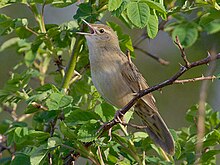| Common grasshopper warbler | |
|---|---|

| |
| Scientific classification | |
| Domain: | Eukaryota |
| Kingdom: | Animalia |
| Phylum: | Chordata |
| Class: | Aves |
| Order: | Passeriformes |
| Family: | Locustellidae |
| Genus: | Locustella |
| Species: | L. naevia
|
| Binomial name | |
| Locustella naevia (Boddaert, 1783)
| |

| |
| Range of L. naevia Breeding Passage Non-breeding
| |
The common grasshopper warbler (Locustella naevia) is a species of Old World warbler in the grass warbler genus Locustella. It breeds across much of temperate Europe and the western Palearctic. It is migratory, wintering in north and west Africa.
This small passerine bird is found in short dense vegetation, often close to water. It is a medium-sized warbler about 13 cm (5 in) long. The adult has a streaked brown back and whitish grey underparts which are unstreaked except on the undertail coverts. The sexes are identical, as with most warblers, but young birds are yellower below. Like most warblers, it is insectivorous. Four to seven eggs are laid in a nest on or near the ground in thick vegetation or in a tussock of grass.
This is a species which skulks in the undergrowth, creeping through bushes and low foliage, and which is very difficult to see except sometimes when singing from a prominent position. The song, which gives this species its name, is a monotonous mechanical insect-like reeling, often given at dawn or dusk.
- ^ BirdLife International (2017). "Locustella naevia". IUCN Red List of Threatened Species. 2017: e.T22714657A118740792. doi:10.2305/IUCN.UK.2017-3.RLTS.T22714657A118740792.en. Retrieved 12 November 2021.
